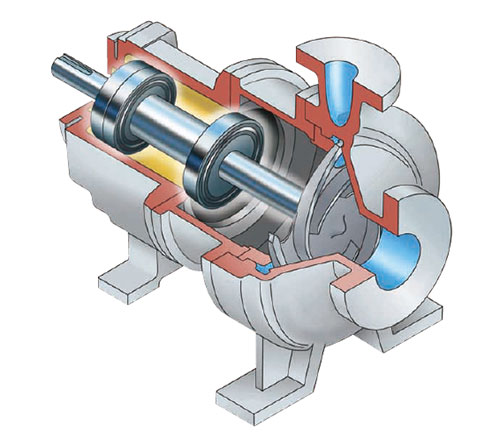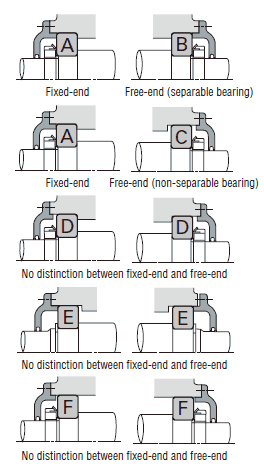
In general, shafts are supported by only two NSK bearings. When considering NSK bearing mounting arrangement, the following items must be investigated:
- Expansion and contraction of the shaft caused by temperature variations.
- Ease of NSK bearing mounting and dismounting.
- Misalignment of the inner and outer rings caused by deflection of the shaft or mounting error.
- Rigidity of the entire system including NSK bearings and preloading method.
- Capability to sustain the loads at their proper positions and to transmit them.
Fixed-End and Free-End Bearings
Among NSK bearings on a shaft, only one can be a "fixed-end" bearing that is used to fix the shaft axially. For this fixed-end bearing, a type which can carry both radial and axial loads must be selected.
NSK bearings other than the fixed-end one must be "free-end" bearings that carry only radial loads to relieve the shaft's thermal elongation and contraction.
If measures to relieve a shaft's thermal elongation and contraction are insufficient, abnormal axial loads are applied to NSK bearings, which can cause premature failure.
For free-end bearings, cylindrical roller bearings or needle roller bearings wiht separable inner and outer rings that are free to move axially (NU, N types, etc.) are recommended. When these types are used, mounting and dismounting are also easier.
When non-separable types are used as free-end bearings, usually the fit between the outer ring and housing is loose to allow axial movement of the running shaft together with NSK bearing. Sometimes, such elongation is relieved by a loose fitting between the inner ring and shaft.
When the distance between NSK bearings is short and the influence of the shaft elongation and contraction is negligible, two opposed angular contact ball bearings or tapered roller bearings are used. The axial clearance (possible axial movement) after the mounting is adjusted using nuts or shims.
The distinction between free-end and fixed-end bearings and some possible bearing mounting arrangements for various bearing types are shown below.

Bearing A
- Deep groove ball bearing
- Matched angular contact ball bearing
- Double row angular contact ball bearing
- Self-aligning ball bearing
- Cylindrical roller bearing with ribs (NH, NUP types)
- Double row tapered roller bearing
- Spherical roller bearing
Bearing B
- Cylindrical roller bearing with ribs (NU, N types)
- Needle roller bearing (NA type, etc.)
Bearing C (1)
- Deep groove ball bearing
- Matched angular contact ball bearing (back-to-back)
- Double row angular contact ball bearing
- Self-aligning ball bearing
- Double row tapered roller bearing (KBE type)
- Spherical roller bearing
Bearing D, E (2)
- Angular contact ball bearing
- Tapered roller bearing
- Magneto bearing
- Cylindrical roller bearing with ribs (NJ, NF types)
Bearing F
- Deep groove ball bearing
- Self-aligning ball bearing
- Spherical roller bearing
Bearing Mounting Arrangements and Bearing Types
Notes:
(1) In the figure, shaft elongation and contraction are relieved at the outside surface of the outer ring, but sometimes it is done at the bore.
(2) For each type, two NSK bearings are used in opposition.
